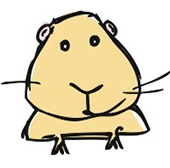
Diet
A good quality hay or grass is essential for maintaining healthy teeth and a healthy digestive system. Guinea pigs should have constant access to hay (all day and night). They also require a 'nugget type' dry food – avoid feeding muesli-type mixes as guinea pigs will leave the bits they do not like (usually the bits containing the important fibre!). Fresh vegetables should also be offered daily. As they are high in sugar, fruits should only be given occasionally and in small quantities.
Guinea pigs are unable to generate their own Vitamin C, therefore they need to get it from their diet. Good quality guinea pig nuggets will contain Vitamin C, however nutrients can disappear if the food is stored for too long so be careful to follow manufacturers shelf life and storage suggestions.
Do not suddenly change your guinea pig’s food as it may upset their digestive system, so always introduce new foods gradually over a period of at least a week.
Guinea pigs produce two types of droppings – hard, dry ones (true faeces) and dark, shiny smelly ones (caecotrophs). They will eat the caecotrophs, usually straight from their bottom, so don’t be alarmed if you see this! Doing this means they get all the goodness out of their high-fibre diet.
Water should always be available, either in a suitable water bottle with a metal spout, or in a bowl. Whichever is used, they should be kept clean at all times.
Housing
Guinea pigs require a safe and comfortable home. If kept outdoors, they require a large weatherproof hutch that is raised off the ground. As guinea pigs are sensitive to temperature extremes, the hutch should be positioned out of direct sunlight and strong winds. In winter, they should be housed inside (e.g. in a shed). Their hutch should be the largest you can afford as the more space they have the better. A large exercise run on a grassy shaded area should also be provided. In cold weather, they will require an indoor exercise area.
Ensure that both hutch and run are escape-proof and safe from predators. If housed indoors, make sure your guinea pig does not have access to any electric cables, as they are likely to chew them. Care should also be taken to restrict any access they may have to plants and flowers in case they ingest one that is toxic or that may have been sprayed with a pesticide or herbicide. Plants or flowers that are poisonous include: bluebell, foxglove, dock, poppy, ragwort, tulip, crocus, laburnum, yew, daffodil and hyacinth.
The hutch should be lined with a 2 - 5cm deep layer of woodshavings or shredded paper, with soft hay or straw on top. Their sleeping area must contain extra hay or straw or shredded paper as bedding. All bedding materials should ideally be dust-free.
Their hutch will need to be cleaned at least once a day, removing any wet or dirty bedding and any uneaten fresh food, and cleaning and refilling food and water containers. You will also need to clean the hutch more thoroughly, at least once a week, to keep it clean and hygienic.
Exercise and Enrichment
Guinea pigs need lots of exercise and with a large enough hutch and run they can get this. They also need places to hide, as they are potentially easily scared, and enrichment to keep them occupied – large tubes, cardboard boxes and pots can be provided for them to explore, as well as toys and untreated logs. Encourage your guinea pig to stay stimulated by rotating toys (offering different toys during different weeks).
Guinea pigs can also be groomed. Longhaired guinea pigs will need to be groomed every day – this can be done gently with a soft brush.
Companionship and Behaviour
As they are very social animals, guinea pigs do need the company of other guinea pigs. If they live on their own they may become very stressed and lonely.
The best combination of guinea pigs to keep would be littermates of the same sex, as this minimises the chance of them fighting. Unneutered males and females should not be housed together as they will breed.
Rabbits are not suitable companions for guinea pigs. They have different dietary and behavioural needs. Rabbits can also potentially carry a bacteria, which if passed to a guinea pig can cause respiratory disease.
General Health
Be sure to check your guinea pig closely every day for any signs of illness.
These may include:
- Diarrhoea
- Loss of appetite
- Drinking more or less than normal
- Lethargy
- Unusual breathing
- Runny eyes or nose
- Significant weight change (loss or gain) in a short period of time
- Limping
- Skin conditions
- Swellings
Any other unusual signs or changes in behaviour could also indicate the possibility of illness. If you are concerned about the health of your guinea pig, do not hesitate to contact the surgery.